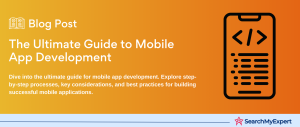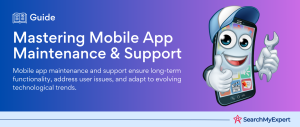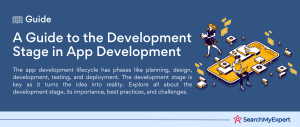Embarking on the journey of developing and deploying a mobile application in today’s dynamic digital landscape demands meticulous planning and execution. With the generation of applications on platforms like the Google Play Store and Apple App Store, it’s imperative for businesses to follow a streamlined process to stand out. In this guide, we delve deep into the essential steps and best practices for a seamless mobile app deployment and launch.
Understanding Mobile App Deployment and Launch
At its core, mobile app deployment encompasses the installation, configuration, and facilitation of an application or a suite of applications to ensure a triumphant release on various app marketplaces. This process employs a combination of manual and automated strategies, all aiming to make the software system available to the intended audience.
Key Activities in App Deployment:
- Installation: Preparing the environment for the app’s functionality.
- Release: Official introduction of the app to the target marketplace.
- Performance Monitoring: Regularly tracking the app’s functionality, user engagement, and potential issues.
While traditional approaches often relied on on-premise IT setups, contemporary
app development has seen a substantial shift towards cloud services like Microsoft Azure, Google Cloud Platform, and AWS. These platforms offer dynamic solutions, including Platform-as-a-Service (PaaS) and Infrastructure-as-a-Service (IaaS), allowing developers to deploy applications in live environments efficiently.
Pivotal Mobile App Deployment Models
To ensure optimal user experience and maximize outreach, it’s vital to comprehend the various deployment models available:
1. Native Mobile Application Deployment
This model caters directly to device-specific features, allowing applications to interface directly with device Input/Output (I/O) systems, ensuring smoother user interactions.
2. Hybrid Mobile Application Deployment
This approach merges the benefits of native applications with HTML5 frontend. It ensures the versatility of HTML5 while retaining the robustness of native application frameworks.
3. Web (HTML5) Mobile Application Deployment
Web applications provide a consistent user experience across platforms via browsers. Although they can’t be directly published on major app stores, they offer flexibility in deployment.
4. Mobile Enterprise Application Platform (MEAP)
Ideal for addressing challenges like device diversity and varying network conditions, MEAP provides a unified platform to cater to broad deployment needs, especially when a holistic strategy is required.
Checklist for Effective Mobile App Deployment
Successfully deploying a mobile application requires adherence to a systematic checklist:
- Understand Developer Policies: Familiarize with the specific guidelines of the platform you are deploying to.
- Account Creation: Set up a developer account, ensuring all details are accurate.
- Synchronized Release Planning: Plan for a simultaneous launch across platforms, or strategize notifications for staggered releases.
- Quality Assurance: Ensure your app conforms to platform-specific quality guidelines.
- API Targeting: Align with platform-specific API level requirements.
- Android App Bundle Creation: Prepare your app for public release, optimizing for device-specific deployments.
- Store Listing: Craft a compelling listing with screenshots, descriptions, promotional materials, and more.
- Bundle Uploading: Choose the right release option, and follow the platform-specific upload process.
- Pre-release Reports Verification: Assess potential issues identified during automatic testing.
- Define Monetization and Distribution Models: Decide between free or paid models and select target geographies.
- Finalize App Content Rating: Ensure alignment with platform policies for age-appropriateness.
- Official Mobile App Launch: Double-check all prerequisites and officially release your app.
Best Practices for Seamless App Deployment
- Follow the Deployment Checklist: A structured checklist ensures no step is overlooked.
- Leverage Apt Tools: Tools like TestFlight, Jenkins, and Fastlane can significantly enhance deployment efficiency.
- Integrate Continuous Integration (CI) Server: Facilitate real-time error detection during deployment.
- Prioritize Automation: Utilize CI/CD tools to streamline processes and reduce manual errors.
- Rollback Plan: Prepare for potential issues with a robust rollback strategy to revert to functional app versions.
Navigating Post-Launch Scenarios: Maintenance and Updates
After the initial deployment, an app’s journey is far from over. The digital ecosystem is ever-evolving, and user preferences are constantly changing. To ensure long-term success and relevance, businesses must prioritize post-launch activities.
Monitoring and Analytics
Once your application is live, it’s crucial to monitor its performance. Platforms like Google Analytics and Firebase provide insights into user behavior, app crashes, and engagement metrics. By understanding how users interact with the app, businesses can make informed decisions on future updates and improvements.
Gathering User Feedback
Encouraging user feedback is invaluable. Whether through in-app prompts, online reviews, or direct surveys, user opinions can offer a clear perspective on what’s working and areas of potential enhancement. Addressing user concerns promptly can improve app ratings and foster user loyalty.
Routine Updates
Regular updates serve multiple purposes:
- Feature Enhancement: Introducing new functionalities based on user demands or market trends.
- Bug Fixes: Addressing known issues or glitches that affect user experience.
- Security Patches: With cyber threats on the rise, ensuring your app is secure is paramount. Regularly updating security protocols and patching vulnerabilities is essential.
Optimizing for the Latest Technologies
With the rapid pace of technological advancements, apps must stay current. Whether it’s leveraging the power of augmented reality, integrating with IoT devices, or optimizing for the latest device hardware, staying updated ensures your app remains competitive and offers users the best possible experience.
Engaging with the User Base
Engagement doesn’t end once the app is downloaded. Regular push notifications (without overdoing it), promotions, or loyalty programs can keep users engaged and incentivize regular app usage. However, it’s essential to strike a balance to avoid overwhelming or alienating users.
Backup and Disaster Recovery
In the rare event of data breaches or technical failures, having a robust backup and disaster recovery plan is crucial. Ensuring data integrity and availability can help regain user trust after unforeseen events.
Staying Ahead: Building a Sustainable Mobile App Strategy
As the mobile app marketplace grows denser, merely having a functional app is no longer sufficient. To thrive and achieve sustainable success, businesses must adopt forward-thinking strategies and maintain a proactive approach.
Diversifying Monetization Streams
While many apps start with a single monetization method, such as ads or in-app purchases, diversifying revenue streams can improve profitability. Consider introducing subscription models, affiliate marketing, or premium versions to tap into various user segments and maximize revenue.
Cross-Platform Development
As user preferences diversify, developing exclusively for one platform can limit outreach. Utilizing frameworks like React Native or Flutter allows businesses to cater to both Android and iOS users without building separate apps, optimizing resources, and broadening reach.
Enhancing User Personalization
Modern users expect tailored experiences. By leveraging machine learning and AI, apps can offer personalized content, recommendations, and interfaces based on individual user behavior, significantly enhancing engagement and user satisfaction.
Integrating Augmented Reality (AR) and Virtual Reality (VR)
The realms of AR and VR offer immense potential. From virtual try-ons in shopping apps to interactive gaming experiences, integrating these technologies can elevate the user experience, setting your app apart from competitors.
Adopting Progressive Web Apps (PWAs)
PWAs combine the best of web and mobile apps, offering users a seamless experience without the need for downloading. They are reliable, fast, and engaging, providing an alternative avenue for businesses to engage users.
Regular Training and Skill Upgradation
The tech world is dynamic, and what’s relevant today may become obsolete tomorrow. Regular training sessions for your development team, attending tech conferences, and staying updated with industry news can keep your app at the forefront of technological advancements.
Focus on Community Building
An engaged community can be one of the most significant assets for an app. By fostering a space where users can interact, share feedback, and even assist each other, businesses not only improve app loyalty but also gain valuable insights directly from their user base.
Green and Sustainable App Development
Environmental consciousness is growing among users. By adopting sustainable app development practices, reducing digital waste, and ensuring energy-efficient operations, businesses can cater to eco-conscious users and reduce their digital carbon footprint.
Conclusion
Mobile app development deployment and maintenance is a journey, not a destination. By continually adapting, learning, and evolving, businesses can ensure their app remains relevant and valuable to users. Embracing change, adopting new technologies, and maintaining a user-first mindset are pivotal in navigating the ever-evolving digital landscape. The key lies in understanding that every challenge is an opportunity for growth, innovation, and improved user engagement.
Searching for elite Mobile App Developers? Look no further.
Further Reading
- Idea Conception Stage In App Development
- Mobile App Design Trends
- Development Stage In App Development
- Mobile App Quality Assurance
- Mobile App Maintenance And Support
Table of Contents
Toggle






